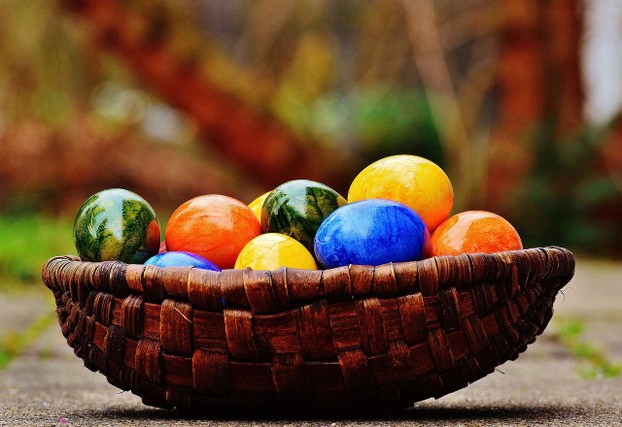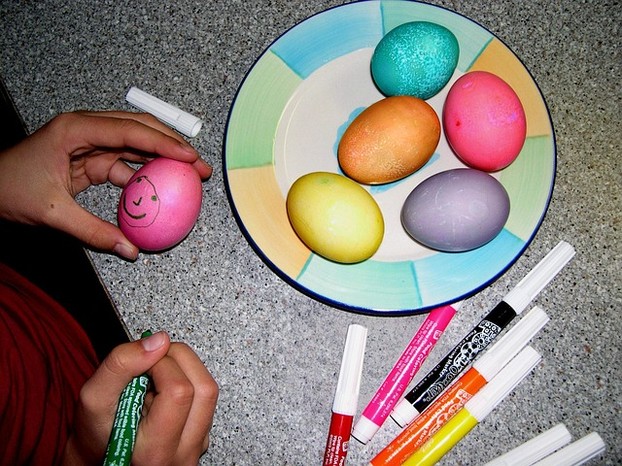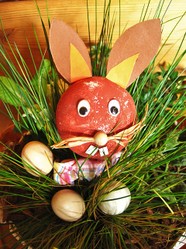Dyeing Easter eggs is very likely the most known (and one of the oldest) traditions related to this biggest Christian holiday. Eggs represent new life, fertility, optimism, and abundance. There are hundreds of dyes on the market, but we can find some spectacular options in nature as well:
Onion skins are probably the most known source of natural dye. Depending on the shade of onions and egg shells, concentration of dye and time in the solution, we can create many different reddish or brownish colors. For best results, rub eggs with some oil when the dyeing process is already finished.
- Chopped purple cabbage will create bluish or greenish eggs, depending on the color of the egg shells.
- Eggs will become yellow if you use ground turmeric (one of the most used dyes in the food industry).
- To create the lavender color of Easter eggs, cook them in water with the addition of violet blossoms and some lemon juice.
- Beet will give a pinkish look of eggs with white shells.
- Walnut shells will color Easter eggs with dark brown tones.
All these natural dyes give you plenty of options to involve the kids, including preschoolers, as active as you want.
So play a bit with the colors, combine them, try to achieve the trendy ombre look by soaking eggs at varying levels for different amounts of time, ...
Apart from obvious ones, there are numerous alternative ways of using Easter eggs:
- you can use Easter eggs (with names of guests, smileys with their initials, or even maybe their small portraits) instead of place cards
- with an addition of some paper, you can easily transform eggs into bodies or heads of different animals, like chicken or rabbit







 Pinterest Tipson 11/22/2024
Pinterest Tipson 11/22/2024
 Make Your Printable Advent Calendaron 11/19/2023
Make Your Printable Advent Calendaron 11/19/2023
 Best Free Portfolio Sites for Artists and Designerson 10/06/2023
Best Free Portfolio Sites for Artists and Designerson 10/06/2023
 Thinking About Painting Your Walls Pink?on 06/17/2023
Thinking About Painting Your Walls Pink?on 06/17/2023


Your suggestions in comment section below are also appreciated.
It depends on each individual, really. Some will become bored at ten, other will enjoy till their late teen age.
Sorr, I am not familiar with such a recipe. We eat chestnuts mostly just roasted and rarely use them in sweets. Italy and France probably use them much more.
Maybe, DerdriuMarriner, maybe;-)
An independent city here has as its public-library director that system's branch manager. Annie is sensitive to audience interests and needs. So this month she organized dinosaur exhibits and experiences.
When I was there yesterday, I read from one of the Smithsonian magazine-cited sources about dinosaur- and turkey-skeleton correspondences, such as the wishbone!
Well-thought-out activities render themselves to adaptation, such as this, your Easter-crafts wizzley. Easter-egg crafts show up beautifully, educationally, entertainingly, unforgettably as Thanksgiving dinosaur-egg crafts, wouldn't it seem?
So any one with time to begin organizing or to reorganize Thanksgiving activities should consider adapting your Easter-craft wizzley to unforgettably fun-filled dinosaur-styled Thanksgiving egg basketing, catching, hunting and racing!
Last night I started, and everything works wonderfully fast.
The second activity under the first, Decoration idea deals with "creating a basket for Easter eggs, candy, flowers, (made of paper, wicker, mason jar, egg carton, old umbrella, flower pot, tote bag."
Area trees still have some black walnuts and chestnuts.
Might it be a fun activity to make baskets for black walnuts whose exteriors might present interesting surfaces with different paint colors?
The first item under the second paragraph to the first idea, Decoration, gives as child- (and grown-up- ;-D) friendly activities "making banners, door hangers, floor, windows and walls decorations."
What colors, materials and sizes might be the fetchingest and -- to be included in subsequent-year background materials to inspire the current-year output -- longest-lived and longest-loved?
Some people commit to the same crafts with some variation even as others commit to different crafts yearly.
Each year the children get older and more astute at making their own decisions as regard to crafts that can be carried out less or more awkwardly, with less or more alacrity.
What is the age range that these activities appeal to?
Your comment from Aug. 31, 2023, identifies potica with "cottage cheese/estragon, poppy seeds, hazelnuts, carob, and different combinations fillings."
Black walnuts and chestnuts number among the yard leaves last month and this month. So they rank high for wild edibles for Halloween and Friends- and Thanks-giving fun.
Would chestnuts be something that would be popular and tasty in crepes?
This wizzley helps for organizing young activities for get-togethers not just Easter-inspired.
For example, crafts and edibles with eggs, jellybeans and nuts and games with balloons inspire fun Friends- and Thanks-giving and funny Halloween get-togethers.
Beets, turmeric and walnut-shell dyes might create Halloween-type red and yellow and brown eggs.
But would the purple cabbage that you mention make green-colored eggs just ghastly and ghostly enough for Halloween edibles?
Thank you for the walnut-related information. In particular, I appreciate the bitter-countering addition of honey and -- if it's raw, unprocessed like what Starbucks condiments with their drinks here -- sugar and the replacement factor of hazelnuts!